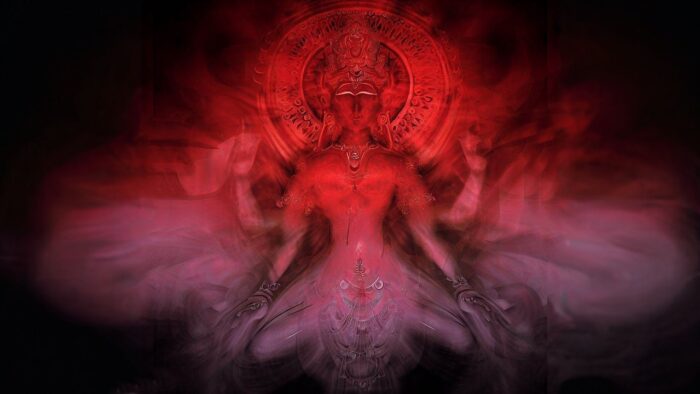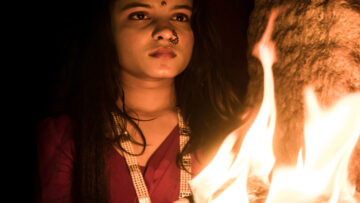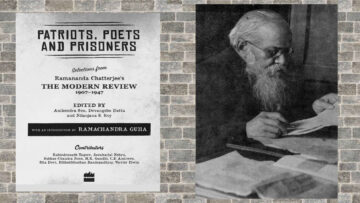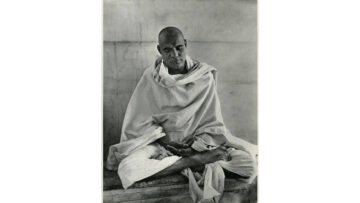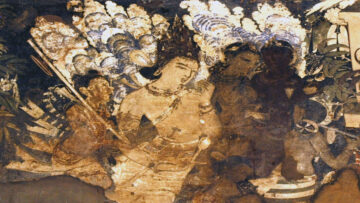In his spectacular commentary on the Bhagavat Gita (GitārthaSaṅgraha), Ācārya Abhinavagupta makes a reference to a work of his, called the ŚivaŚaktiAvinābhāva Stotra (Ode to the Inseparable Śiva & Śakti). Quoting verses from this Stotra, Ācārya writes two verses on Devī which have come to be known in the Kāshmira Śaiva tradition as Devī Stotra, Devī Stava or the Śiva-Śakti Stotra. This reference to Devī, in the context of his explanation to the verses on the nature of Puruṣottama (15.19), have been stated passingly by Ācārya. However, as is always the case with His work, it cannot be glossed over by any true devotee of His genius. The beauty and depth of these verses are profound and within the oral tradition they are held in very high esteem. The verses are as follows [1]:
“तवचकाचननस्तुतिरम्बिके
सकलशब्दमयीकिलतेतनुः।
निखिलमूर्तिषुमेभवदन्वयो
मनसिजासुबहिष्प्रसरासुच॥1
इतिविचिन्त्यशिवेशमिताशिवे
जगतिजातमयत्नवशादिदम्।
स्तुतिजपार्चनचिन्तनवार्जिता
नखलुकाचनकालकलापिमे॥“
Translation by Swami Lakshmanjoo:
(“O divine Mother Ambika! There is nothing whatsoever in the form of the spoken word, which is not a hymn, or which does not constitute praise to Thee. Whether one prays reverently in a Church or a Temple, or whether one is engaged in worldly talk, in reality, it is all praise of You, because all words and all sounds are made up of letters which pervade Your body. By virtue of this, whatever forms appear in this universe, or whatever ideas or thoughts arise in my mind, be they good or bad, they invariably afford me the opportunity to perceive You and embrace You.
Thus, O Mother, as the consort of supreme Bhairava, you are ever intent on removing all afflictions and sufferings, without any effort on my part. Therefore, there is neither any action, like meditation, or puja, nor are there any words, like singing praise or uttering mantras, which do not constitute my worship of You.”)
This article is neither a commentary nor an interpretation of these verses as the author doesn’t consider himself an Adhikāri for this feat. However, any man who takes a dip in the infinite ocean of pure knowledge, that is Ācārya Abhinavagupta, cannot be expected to return dry and untouched by its divine waters. Therefore, this article is to be read as an exploration of love by a seeker based on what he has learnt from his Guru, Śastra and his own limited experience.
The Nature of Devī
The Devī Stotra is a hymn praising the Goddess, explaining her nature in a short verse. Who is this Goddess that is being prayed to? Swami Lakshmanjoo clarifies through his oral transmission that the Devī being referred to here is SvātantryaŚakti [2].
SvātantryaŚakti can be defined as the “Absolute Ubiquitous Freedom” of Śiva. She is Absolute, because there is no higher Śakti; Ubiquitous, because she is present everywhere, at all levels (from the highest to the lowest), at the same time and she is the form of Freedom because she is the supreme will of Śiva. Therefore, Swami Lakshmanjoo describes Her elsewhere as the “Free will” of Bhairava, which is the source of his infinite śaktis, of which the major ones are five in number, namely: Chit, Ānanda, Icchā, Jñāna and Kriya Śaktis [3]. With reference to the śaktis mentioned, SvātantryaŚakti can be also explained as absolute freedom in icchā, jñāna and kriya. It is important to note that Śakti here does not simply mean Power, but “Conscious Intelligent power” as it is the blossoming of Chidānanda.
Being the absolute ubiquitous freedom of Śiva, She is understood to be the very nature of Śiva, just as heat and light are the very nature of Fire [4]. SvātantryaŚakti is also known and understood by various names in the tradition such as Vimarśa, Caitanyam, ParāVāk, Sphurattā, Spanda and Hṛdayam amongst others [5]. The varying facets of SvātantryaŚakti are to be understood as various ways of seeing the same Śakti principle within the frameworks of the sub-traditions of Kashmir Shaivism.
Devī as Aṃbika
The word Aṃbika refers to “mother”. Devī is designated as Aṃbika because she is the mother of the universe. This is made abundantly clear in the first sutra of Pratyabhijñāhṛdayam, which states: “The absolute Chiti of its own free will is the cause of the Siddhi of the universe.”[6]. The Absolute Consciousness, which is qualified as “that” which possesses SvātantryaŚakti, is the cause of the manifestation of the Universe. Therefore, it is with clear intent, that Devī is affectionately and devotedly referred to as Aṃbika, by Ācārya Abhinavagupta. By this reference, he seeks to celebrate her role as the mother of the universe and the primordial cause of all existence.
The Nature of worship
The Devī Stava describes a vision of the manifest world which is in-line with the core philosophy of Kashmir Shaivism. Consciousness is not just transcendental but is equally imminent at the same time. This is possible owing to the ubiquitous freedom of Śiva, i.e. Devī. The aspect of imminence is achieved by Consciousness (Chiti) through her expansion in the form of the six-fold pathways or adhvans of vācya (objective cycle) and vācaka (subjective cycle). This follows that all letters, words, sentences are the vācakādhva and all the kalas (enclosures), tattvas (elements) and bhuvanas (there are 118 universes according to oral tradition) are the vācyādhva [7]. Since all upayas (techniques of worship), as well the results of worship, are traceable within these adhvans, they constitute only a part of Her universal body. Considering this view, what does not constitute Her worship?
Ācārya Bhaṭṭa Narayana gives us a very similar prayer in his great devotional work, the Stava Chintāmani [8]:
“By which path you are not achieved, which word does not indicate you? Which meditation does not have you have you as its goal, what is existing in this world is one with you O Prabhu?“
It is very clear that in this tradition, worship is understood very differently by the normal everyday understanding of worship. In this darśana, the worshipper, the method and means of worship, the one who is worshipped and the impediments as well (whose removal is the purpose behind the worship) are one with that Absolute Universal Consciousness. The spirit of this form of Advaita Bhakti, that is integral to Kashmir Shaivism, is captured very succinctly in the first verse of the Śivadṛṣṭi by Ācārya Somananda[9]:
“Let Śiva who is my own nature bow down to his real nature (Universal Śiva) through His own Śakti (energy) for the removal of bondages and obstacles which are also Śiva”.
The Upaya to Recognize Her
The first verses of the Devī Stava which describes her nature as all words and forms, is essentially a form of dharana. By the cultivation of this dharana, the sadhaka, with the grace of Śiva, realizes this in his lived experience. He then sees this very “existence” as Devī herself, wherever and whenever it is examined.
In the Vijñānā Bhairava Tantra, a very similar dharana is mentioned [90th dharana]. Swami Lakshmanjoo comments on it as follows [10]:
“Wherever the mind goes, whether outside or within, there itself is the state of Śiva. Since he is all pervading, where else can the mind go? “
Here too, the emphasis is not on a rigid concentration on something exclusive, but a universal expansion of one’s awareness.
Blurring Lines between Spiritual and Secular
The recognition of Devī as all names, forms, and all acts has some extra ordinary consequences in the life of a yogi. It effectively blurs the rigid boundaries between what we call “spiritual practice” and “secular life”. In the second verse, Ācārya Abhinavagupta states clearly that it is not only stuti, japa, archanā, cintanā etc. that constitutes her worship but each and every act is by default, Her worship. This presents a quandary to us sadhakas: Why then must we do sadhana etc.? Can we drop all our meditations and live as we please?
Here one must remember that the second verse is a natural consequence of the first one. Therefore, the question of doing and not doing does not arise, as the Yogi who is established in the dharana (mentioned in the first verse), cannot but experience everything he does as the worship of Ambika, both in action and intention.
Negation of Exclusivity
Another interesting observation about the Devī Stava is the use of the negative sense. Ācārya Abhinavagupta could easily have stated simply that all forms and names are Devī’s and all acts are but a worship to Her. However, he uses the negative mode to question, in a state of awe, what is not her name and form and what is not her worship. One could argue that it is only to invoke “poetic beauty” that he states it this way. However, with Ācārya, could it be so simple? Perhaps there is more to examine here.
Experience, in its most natural primordial form, in universal in nature. Any exclusion is, by definition, moving away from universality. Therefore, exclusion can be understood as a form of limitation itself. When seen in this light, the three malās (impurities) that limit us are essentially the effects of some sort of exclusion of experience. Could it be that the negative sense is used, by Ācārya Abhinavagupta, to emphasize the negation of the “exclusion in experience”? By this emphasis on negation, the capacity to embrace our universal nature naturally grows. The exclusivity of certain names, forms as belonging to Devī and certain acts alone constituting Her worship, are being challenged and broken down in this view. Most importantly, the negative sense also includes the transcendental aspect as well, i.e. the nameless and the formless is also Devi, and the lack of action is also worship. In effect, “every-thingness” and “no-thingness” are both embraced and integrated, in Pūrṇārtha (Completeness).
Do note that this “negation of exclusion” is different from the negation implied by the “neti – neti” process. The former destroys those barriers that limit our universality whereas the latter is meant only to discover the transcendental nature of the Self.
Take Away
Therefore, we can conclude that the Devī Stotra, although comprising just two verses, is a great Ocean of Amrita, that is capable of bestowing the Param Padam (Highest state). It is a testimony to the genius of Ācārya Abhinavagupta and definitive evidence that He is verily the embodied form of that ParaBhairava, who is Anuttarā (Unsurpassable) and Anākhya (inexplicable).
References
[1] Goddess Within – Hymns to the Divine Mother,https://www.abhinavagupta.org/hymns/track-6-Śiva-Śakti-stotra/
[2] https://www.lakshmanjooacademy.org/devi-stotra-by-abhinavagupta/
[3] Footnotes on Verse 5, Light on Tantra, Swami Lakshmanjoo, Lakshmanjoo Academy
[4] Verse 68, Light on Tantra, Swami Lakshmanjoo, Lakshmanjoo Academy
[5] Pages 16-19, Parapraveshika -Shri Ram Shaiva Trika Ashram
[6] Page 46, PratyabhijnaHrudhayam, Jaideva Singh
[7] Chapter 2, Kashmir Shaivism- Secret Supreme, Swami Lakshamanjoo, Lakshmanjoo Academy
[8] Verse 21 of Stava Chintamani, Magical Jewel of Devotion, Swami Lakshmanjoo, Lakshamnjoo Academy
[9] Translation found on https://www.universalshaivafellowship.org/
[10] Page no 217, The Manual For Self Realization, Swami Lakshmanjoo, Lakshmanjoo Academy.
Feature Image Credit: Author Jayadev
Disclaimer: The opinions expressed in this article belong to the author. Indic Today is neither responsible nor liable for the accuracy, completeness, suitability, or validity of any information in the article.

